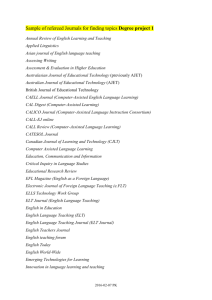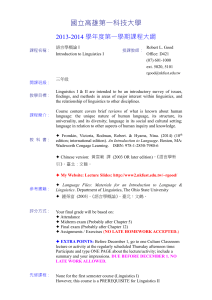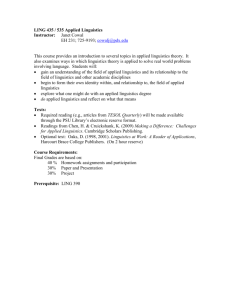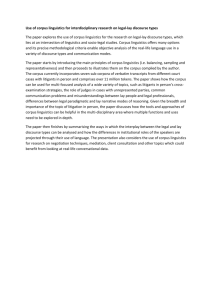ELT/ESP/EYL Professional Practice
advertisement
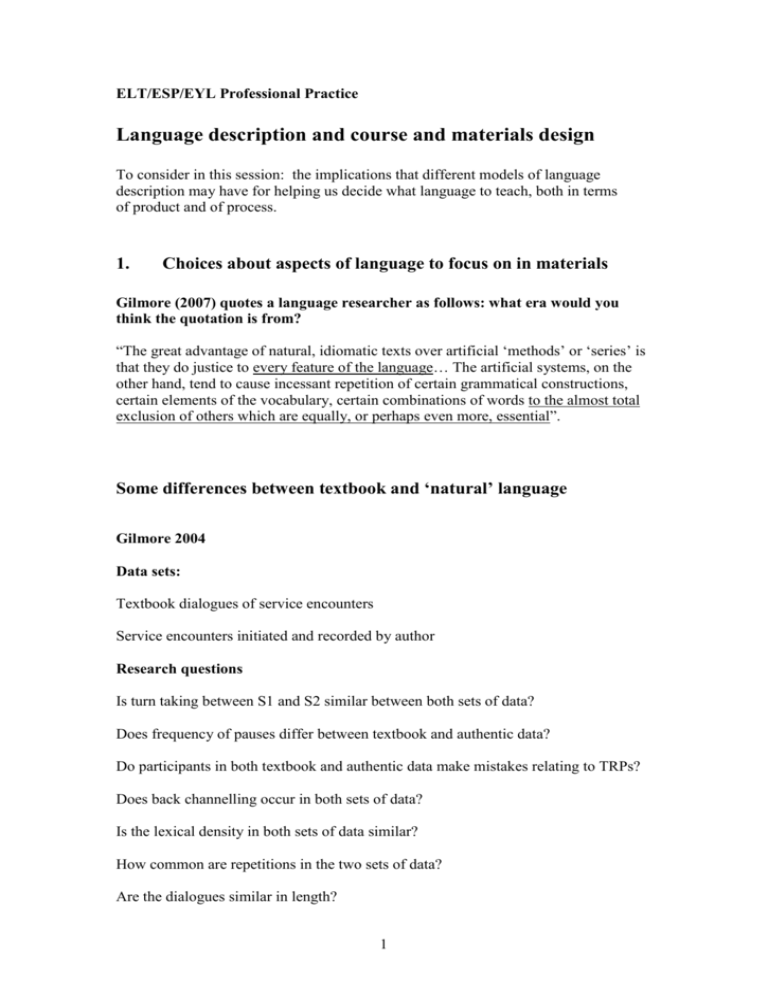
ELT/ESP/EYL Professional Practice Language description and course and materials design To consider in this session: the implications that different models of language description may have for helping us decide what language to teach, both in terms of product and of process. 1. Choices about aspects of language to focus on in materials Gilmore (2007) quotes a language researcher as follows: what era would you think the quotation is from? “The great advantage of natural, idiomatic texts over artificial ‘methods’ or ‘series’ is that they do justice to every feature of the language… The artificial systems, on the other hand, tend to cause incessant repetition of certain grammatical constructions, certain elements of the vocabulary, certain combinations of words to the almost total exclusion of others which are equally, or perhaps even more, essential”. Some differences between textbook and ‘natural’ language Gilmore 2004 Data sets: Textbook dialogues of service encounters Service encounters initiated and recorded by author Research questions Is turn taking between S1 and S2 similar between both sets of data? Does frequency of pauses differ between textbook and authentic data? Do participants in both textbook and authentic data make mistakes relating to TRPs? Does back channelling occur in both sets of data? Is the lexical density in both sets of data similar? How common are repetitions in the two sets of data? Are the dialogues similar in length? 1 Is the frequency of hesitation devices similar through both sets of data? What does Gilmore’s data suggest about the aspects of language which the coursebook materials are choosing to focus on? What aspects does it suggest that the coursebook has left out? 2. Recent development in language description that we may want to take into account Pragmatics - the norms of interaction “Sociolinguistic research on the speech behaviour of native speakers of English is important not only for establishing descriptions of how we perform verbally in our day-today interactions with other native speakers, but also for the purpose of making use of this baseline information in educational settings”. (Boxer & Pickering 1995: 44.) Genre analysis - textual organisation and communicative purpose Genres, then, provide a frame (Swales 2004) which enables people to take part in, and interpret, particular communicative events. Making this genre knowledge explicit can provide learners with the knowledge and skills they need to communicate successfully in particular situations. It can also provide learners with access to socially powerful forms of language. (Paltridge 2006: 103) Grammar – functional approaches “Grammar becomes a study of meanings are built up through the choice of words and other grammatical resources such as singular or plural, negative or positive, and other linguistic forms such as tone and emphasis”. (Bloor & Bloor 2004: 2) Lexical patterns – corpus evidence “Studies of large corpora provide two main contributions to linguistics. First, they provide many new and surprising facts about language use. This is an important test for an approach to language study: it can help us to learn new things. Second, by looking at language from a new point of view, corpus studies can help to solve paradoxes which have plagued linguistics for at least a hundred years. … Corpus data and methods provide new ways of studying the relations between language system and language use. If a pattern becomes very frequent in use across very large 2 quantities of text, then it becomes entrenched as part of the system. Frequency in text becomes probability in the system.”. (Stubbs 2007: 126). In your experience, to what extent are contemporary materials taking these developments in language description into account? 3. More on empirical linguistics (see Stubbs 2007). Relationships between language data and language system: Language is both an abstract system, and also the use which a community of speakers make of the system. Descriptive, empirical linguistics is based on the second aspect – on the data which we can see. It has ‘disproved’ some descriptive claims based on introspection. Computer-based analysis of corpora: Is inherently quantitative Shows what is usual and what is less usual Shows patterns of lexical behaviour ( KWIC technology) Explanatory inferences can be drawn from observed patterns “By organising huge masses of data, technology can make visible patterns which lie outside unaided human perception and which no amount of introspection or manual analysis could discover”. (2007: 131). 3 4. Theory/Practice interactions “There is nothing so practical as a good theory”. (Lewin, 1952: 246). Where do language description theories come from? Does language description always have implications for language teaching? Teachers, learners and researchers What is the position of language teachers vis a vis language description researchers? Can language teachers generate particular language descriptions? Do they do so? Can learners be asked to generate particular language descriptions? If so how, and using what data? 5. Widdowson 2003: Cautionary points about the scope of linguistic description What, if anything, do developments in language description tell us about the language we should choose for teaching? And what do they tell us about the aspects that we should teach? To what extent is description an adequate basis for prescription? Widdowson’s arguments: Descriptions, however good, should not automatically set pedagogic goals Giving a primacy to description sets linguists in power over teachers. Which description is relevant? “All linguistic descriptions are necessarily limited…. [although] corpus descriptions carry a reality that others do not, it also needs to be recognised… that the reality they represent is only partial.” (Widdowson 2003: 86) Reading Boxer D & Pickering L 1995: “Problems in the presentation of speech acts in ELT materials: the case of complaints” ELTJ 49/1 44-58 4 Bygate, M. 2005. Applied Linguistics: a pragmatic discipline, a generic discipline? Applied Linguistics 26, 4: 568-581. Carter R 1998. Orders of reality: CANCODE, communication and culture. ELT Journal 52/1: 43-56. Carter, R. & Nunan, D. 2001. The Cambridge guide to teaching English to speakers of other languages. Cambridge: CUP. Clarke, M. 1994. The dysfunctions of theory/practice discourse. TESOL Quarterly 28, 1, 9-26. Cook G 1998. The uses of reality: a reply to Ronald Carter. ELT Journal 52/1: 5763. Cots, J. 2006. Teaching ‘with an attitude’: critical discourse analysis in EFL teaching. ELT Journal 60/4: 336-345. Crossley, S. A., Louwerse, M.M., McCarthy, P.M., Y McNamara, D.S. (2007) A linguistic analysis of simplified and authentic texts. Modern Language Journal 91/1: 15-30. Ellis, R. 2010. Second language acquisition, teacher education and language pedagogy. Language Teaching 43, 2: 182-201. Gavioli, L & Aston, G 2001. Enriching reality: language corpora in language pedagogy. ELT Journal 55/3: 238-246. Gilmore, A 2004 ‘A comparison of textbook and authentic interactions’. ELT Journal 58, 4, 363-374. Gilmore, A. 2007. State of the art article: Authentic materials and authenticity in foreign language learning. Language Teaching 40/2: 97-118. Guariento W & Morley J 2001 Text and task authenticity in the EFL classroom. ELT Journal 55/4: 347-353 Hinkel, E. 2006. Current perspectives on teaching the four skills. TESOL Quarterly 40/1: 109-131. Hoey, M. 2005. Lexical priming: a new theory of words and language. London: Routledge Holmes J 1988 Doubt and certainty in ESL textbooks. Applied Linguistics 9/1: 21-44 Hymes D 1972 On communicative competence. In Pride J & Holmes J (eds). Sociolinguistics: selected readings. Harmondsworth, Penguin books. 5 Koprowski, M. 2005. Investigating the usefulness of lexical phrases in contemporary coursebooks. ELT Journal 59/4: 322-332 Lee W 1995: “Authenticity revisited: text authenticity and learner authenticity” ELTJ 49/4 323-328 Lewin, K. 1952. Field theory in social science: selected theoretical papers. London: Tavistock. Nunan D 1988: The Learner Centred Curriculum Cambridge CUP Paltridge, B. 2006. Discourse Analysis. London: Continuum Peacock M 1997 “The effect of authentic materials on the motivation of EFL learners” ELTJ 51/2 144-156 Scotton C & Bernstein M 1988: “ Natural Conversations as a Model for Textbook Dialogue” Applied Linguistics 9/4 372-384 Seidlhofer B (ed) 1998 Controversies in applied linguistics (Section 2, Corpus linguistics and language teaching) Oxford: OUP Stubbs, M 2007. On texts, corpora and models of language. In Hoey, M. et al. Text, Discourse and Corpora: theory and analysis. London: Continuum. Tomlinson, B. (ed) 2008. English language learning materials: a critical review. London: Continuum. Williams M 1988:“Language Taught for Meetings and Language Used in Meetings:Is there Anything in Common?” Applied Linguistics 9/1 45-58 Widdowson HG 2003 Defining issues in English language teaching. Oxford OUP. (chs 7-9) Willis, D. 2007. ‘The logic of spoken English, and how to teach it’. Paper given at TESOL France 2007: available from http://www.willis-elt.co.uk Wong, J. (2002). ‘Applying’ conversation analysis in applied linguistics: evaluating dialogue in English as a second language textbooks. International Review of Applied Linguistics, 40, 1, 37-60. Wong V, Kwok P, & Choi N 1995: “The use of authentic materials at tertiary level” ELTJ 49/4 318-322 6


